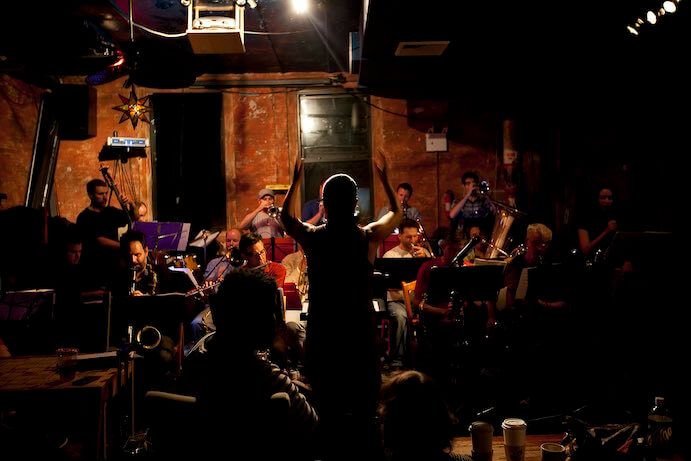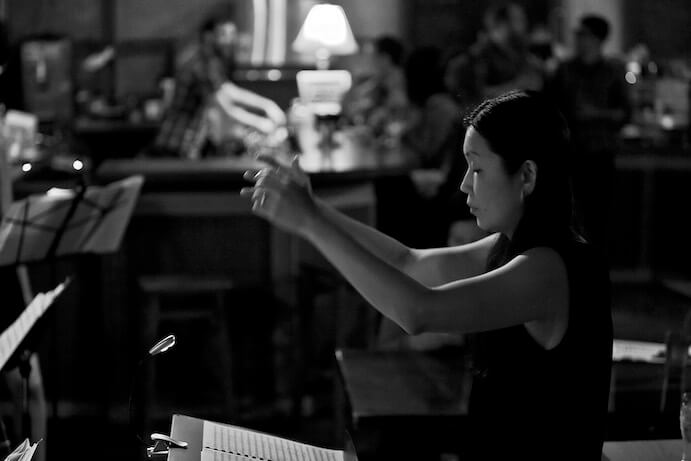This article was commissioned by American Composers Forum.
The first recording of jazz music was made in 1917, and in the 100 years since, it has spread throughout much of the world like wildfire. Jazz is a testament to the brilliance and resilience of the African diaspora, originating in the American South in the early 20th century in the legendary city of New Orleans. But fast forward to today, and jazz is a mature musical genre with generations of diverse practitioners and innovators. In composer, musician, and bandleader Asuka Kakitani, jazz has found an unexpected, but not necessarily unlikely, champion.
The transatlantic slave trade established America as a place of brutality, building white wealth off the bodies and labor of captive and enslaved Africans and their descendants, who were born into slavery. In 1685, the French King Louis XIV issued a decree called the Code Noir, defining the conditions of slavery in the French colonial empire, including present day New Orleans. Later, the Code Noir of 1724 allowed for enslaved Africans to take Sundays off, but there were no provisions that allowed them to gather freely. The Bill of Rights–amendments to the Constitution ensuring the legal rights of citizens, to assemble freely–wasn’t ratified until 1791, and African Americans weren’t allowed citizenship rights until 1878.
New Orleans is home to Louis Armstrong Park, situated in the famed Tremé neighborhood. At the southern corner, across Rampart Street and north of the French Quarter, is Congo Square (Place Congo, in French), established in 1817, which became ground zero for jazz’s evolution. Congo Square was the only place where captive, enslaved African Americans and free Blacks could mingle and play music–but only on Sundays. Open markets as well as meetings and African drumming and dance made the square a hotbed for communication and preservation of culture.
Asuka Kakitani now lives in Minnesota and was a recipient of a 2016 JFund for New Music award (now ACF | create) and a 2019 McKnight Composer Fellowship, both programs of American Composers Forum with funds provided by the Jerome Foundation and McKnight Foundation, respectively. Hot House Magazine described her as “a musical impressionist and supreme colorist,” and she says, “when I found composing, I felt this … sensation [of freedom]. Oh, I can create my wall in my own world, my own story and my own color.”

Hailing from the Japanese city of Osaka, where she was raised like other Japanese people “to not stand out,” Kakitani had no idea that she would eventually make her way to Berklee College of Music in Boston to major in jazz composition. “I started playing the piano because my mom played piano, but [for me] it was just kind of playing around; I was a little kid. And then at some point I started playing electric organ, which was very popular at that time in Japan. I think I was 18- or 19-years-old and I heard [the music of] Bud Powell, who is a bebop jazz pianist. That was a huge shock to me, and it was ‘Wow I just want to fly like him,’ and that became my passion. I wanted to play jazz piano in that style. That led me to go to Berklee College of Music in Boston, [even though] I was already 25 or 26. I got in and I wanted to study piano performance there, and knew it was a big jazz school.”
This long journey as a musician, composer, and a Japanese immigrant in America took her to New York for several years after school, where she and her husband/collaborator, the composer-trombonist JC Sanford, thrived in the incomparable cultural milieu of music and the arts in one of the world’s busiest and most artistically competitive cities.
In New York, she further developed her expertise and style in the genre of big band music and founded the Asuka Kakitani Jazz Orchestra (AKJO), which won accolades for its album Bloom, described by PRI’s The World as “full of complicated harmony . . . but it also makes room for simplicity.”
After Kakitani and Sanford had their daughter, they decided to move to Minnesota where Sanford has family. She has stayed very busy as a working artist; she and Sanford have their own jazz orchestra called Inatnas, and they created the Twin Cities Jazz Composers’ Workshop to provide space for jazz composers to learn from and support each other, to grow the field of jazz composition, and to increase the diversity of jazz composers in her new locale. Kakitani says she was used to working with a lot of white men in school and in New York, and she wants to make sure there’s room in jazz for more people like her–more women, and more people of color.
Kakitani says she has a lot of music she wants to write, including trying new things such as writing for a string quartet. “I’ve been writing for a long time for big band, and at some point I feel like I’m writing kind of the same thing. It’s true that it’s kind of a style, and even though it’s contemporary music and creative music and you can do as you like, I felt like I wanted to do something else. I said after I moved here, I wanted to explore a different kind of music, and just dive in to just write for strings, but without [any preconceptions or] thinking about what the actual string quartet should do.”
It was a radical shift to move from Brooklyn to Northfield, Minnesota, and Kakitani has learned to appreciate the difference, especially in terms of sound. “It’s a small town, and it’s very peaceful. I like the peace. First, I couldn’t believe the silence. In Brooklyn, the noise and sound is just constant.”

Without all the light pollution of the big city, Kakitani, who has always been inspired by nature, has come to associate the simplicity of the darkness with the beauty of small things. “Here, one time I came home in the dark, and there’s really not any street lights. I couldn’t see my feet. I love nature and I love looking inside of this very small flower and seeing a super small insect, perhaps something I can’t see without a lens. Those tiny worlds; I really like these things, and the discovery.”
Minnesota is known for its frigid winters, which Kakitani was not used to, even after living on the east coast. But, perhaps not surprisingly for a composer so attuned to the natural world, who has composed songs titled “Bumblebee Garden,” “Dragonfly’s Glasses,” and “Opened Opened,” she has found her soul nourished by the presence of so much life. “I love seasons, and I grew up with four seasons in Japan, but it’s not like it is here with half of the year being winter. But summer, maybe because of that, is so bright and vibrant, and when the trees bloom, I am so inspired. And even winter is beautiful here. I was thinking, ‘I never lived in this kind of small town.’ I was thinking, ‘I’m more of a city person,’ but it’s really good for my soul, to see the trees all the time, and the bees. I like it.”
From West Africa to New Orleans to Japan to the east coast to Minnesota, jazz continues to shapeshift and dazzle. No matter where Kakitani or her music is, listeners will derive worlds of story, color, and beauty.

This activity is made possible by the voters of Minnesota through a grant from the Minnesota State Arts Board, thanks to a legislative appropriation from the arts and cultural heritage fund.
I CARE IF YOU LISTEN is an editorially-independent program of the American Composers Forum, funded with generous donor and institutional support. Opinions expressed are solely those of the author and may not represent the views of ICIYL or ACF.
A gift to ACF helps support the work of ICIYL. For more on ACF, visit the “At ACF” section or composersforum.org.
























